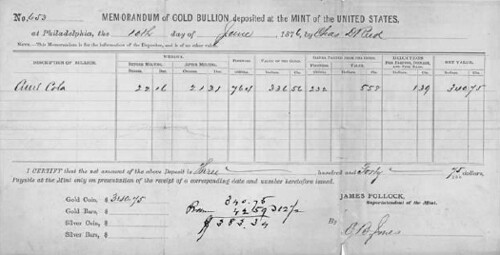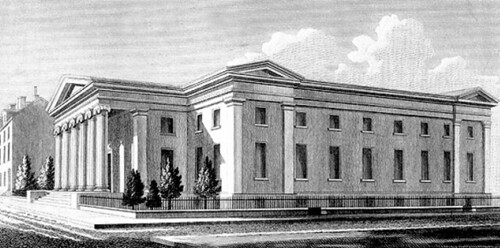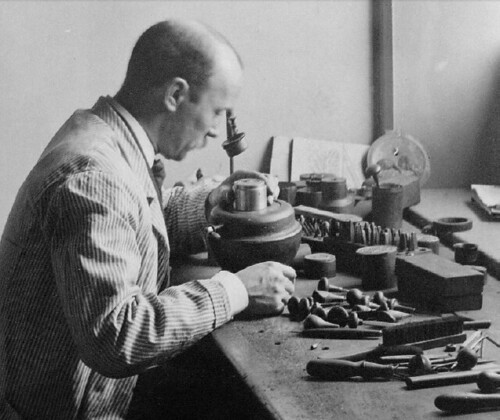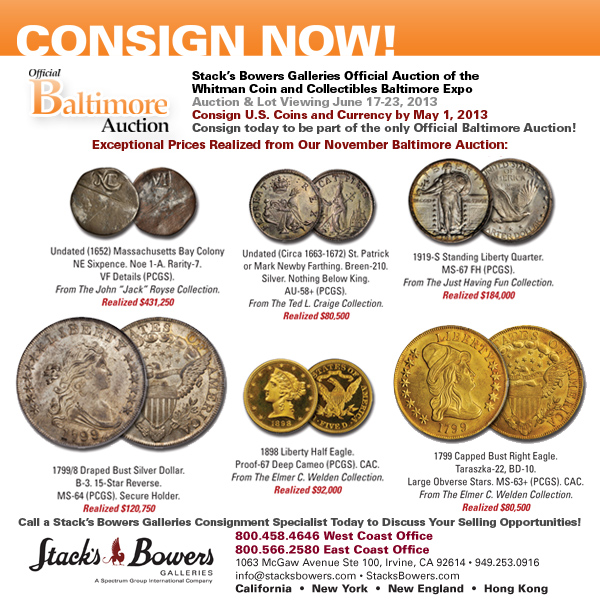
PREV ARTICLE
NEXT ARTICLE
FULL ISSUE
PREV FULL ISSUE
BOOK REVIEW: FROM MINE TO MINT
As Roger notes in his Introduction, the early decades of the Mint have already been thoroughly explored by other researchers, many of whom were consulted and are contributors to this work. E-Sylum readers will recognize the names of R. W. Julian, Len Augsburger, David Lange, and David Ginsburg, all of whom have authored authoritative books and articles on the subject. The book picks up the story of American minting technology with the era of expansion, as the country moved beyond its one rickety old Philadelphia Mint to a new era with newly constructed and appointed mint facilites in Philadelphia and later across the nation, with as many as five mints operating simultaneously. The Introduction is notable for numismatic researchers, providing both a short survey of the available literature on the U.S. Mints and more importantly, a knowledgeable critique of its quality and usefulness. Below is an excerpt: A Paradox of Sources Our “sources” become merely adulterated copies – engravings and all – of their progenitors much like the “copycat” work of modern internet hacks. We have no complete early narrative of how the mints worked. We have no surviving and satisfying history by the operatives of one of the major institutions of this American nation. It is as if the Mint Bureau established a fog shrouded fortress and set to work with wizards at the foot of some great creaking drawbridge. The paradox is that this institution manipulating much of the national treasure, that place of clerks and scribes recording each minute detail, left almost nothing of itself. Although we know that most mint documents are missing and presumed lost, surviving evidence is ample in quantity but poor in quality. Journals of deposits tell us little about the depositors or what the mint workers did once the miner gave up his gold. Not one ordinary worker seems to have recorded his or her impressions, daily routine or thoughts on working at the mint. The piles of journals are outputs of human machines with no more clear recognition than abacus, adding machine or electronic calculator. The book does much to sort through the fog of history to illuminate the changes and innovations in technology accomplished by the engineers and mechanics of the Mint: As a new country, European nations viewed America as a rude cousin not ready for international leadership. The Royal Mint and its continental counterparts seldom visited American mints, and when they did so their conclusions were likely commonly: “We’ve been doing that for many years. There’s nothing to learn from them.” There was much truth to such sentiments, but there was also much the continentals overlooked. The United States Mint was a mere infant compared to the Royal Mint with its lengthy archive of processes, data and materials. The Philadelphia Mint was also a late adopter of steam engines as the power source for metal forming and minting equipment. But what American engineers did was to use their late start as a means for separating out technology that was unstable, overly complex or proprietary. In mid-1835 we find Philadelphia engineer/machinist Benjamin Franklin Peale discarding most of the complexity and tradition attendant to press design work of Thonnelier in Paris, Uhlhorn in Karlsruhe, and Boulton in London. Peale went to basic principles of equipment used at these great mints, and adapted it to the American model of efficiency. Equipment had to be robust and easy to repair. The vast distances of North America made it impossible to have mechanical experts at each mint, sitting, waiting for something to break. The book's first three chapters focus on the basics of refining and minting. Chapter One opens with a discussion of bullion and the various forms in which it arrived at the Mint's doorstep, including gold dust, gold amalgram, laminated gold, gold cakes, "Plata Pina Silver Amalgram" and silver plate. Included is a discussion of the weight and fineness of private gold coins such as those of Templeton Reid and the Bechtlers. These were accepted for recoining along with any non-U.S. gold coins, based on their gold content.
 Philadelphia Mint Bullion Deposit form
Philadelphia Mint Bullion Deposit form
The next part focuses on minting operations in more detail, noting the differences in techniques and results in different time periods and at different mints. One thing I learned here was that until the late 1930s only one denomination at a time would be worked in each step of production - that was the primary method of quality control and avoided the problem of mixed planchets. The various steps include rolling ingots, cutting or blanking to create planchets, adjusting their weight, upsetting or "milling" the edge, and finally striking the coins. Chapter Three covers the various Mints and Assay Offices of the U.S. from 1833 to 1937. The first mints beyond Philadelphia were located in the gold regions of Charlotte, NC and Dahlonega , GA. Next came a southern mint for both gold and silver in New Orleans, LA.

Architect's Drawing of the Second Philadelphia Mint This chapter includes architectural diagrams and floor plans for the mint beginning with the second Philadelphia Mint, which opened in 1833. Visitors were met by a corps of polite, efficient and good natured guides who directed depositors to the correct location for depositing gold, and organized visitors into small tour groups. The six guides (known as "conductors") earned $3.50 per day, wore uniforms and presented themselves as part of the security force, but it was unclear if they would actually be of help in an emergency.

A Portion of the Mint's Coin Collection in 1888 I enjoyed the picture of the Mint's doorkeeper seated next to a Gatling gun. Robbers, beware! Even more of a delight was the section on the Engraving Department and Cabinet of Coins. Next is covered the Third Philadelphia Mint building, opened in 1892. As with all of the Mints discussed in the book, each of the minting processes departments is described. This section has a good bit of information about the Mint coin collection, which was quite a popular tourist attraction. The chapter continues with similar treatments of the New Orleans, Charlotte, Dahlonega, the first and second San Francisco Mints, the Carson City Mint, and the Denver Mint. Also covered are the various Assay Offices, beginning with New York. Coincidentally, the book includes a brief discussion of the Wall Street bombing of 1920, which we mentioned in last week's E-Sylum. The bomb had been concealed in a horse drawn wagon. Stones in the assay office façade had to be replaced, as well as metal window sash, grill work, interior marble and plaster in the lobby, and window glass throughout the front side. The new building had been accepted by the government in August but opening was delayed to repair damage from the bombing. Chapter Four covers the Officers of the Mint Bureau and their functions, from cashier to coiner to engraver and Director. Chapter Five is titled "Working at the Mint" and is particularly interesting given the factors of politics, gender and class. Many laborers performed backbreaking work for endless hours while others got paid for doing next to nothing. Chapter Six, "Operating Policies and Procedures" rounds out Part One of the book. Part Two dives into "Detailed Department Operations" in Chapter Seven, describing how each department worked, Mint by Mint. Here readers can compare and contrast the operations at the mother mint and the various branches. As with part One, there are a number of great pictures throughout. Medal collectors will enjoy the section on the Medal Department, beginning on p322. Another section covers the manufacture of proof coins. The section on the Engraving Department focuses on the technology and processes.
 Engraver Charles E. Barber working on a medal die in 1888
Engraver Charles E. Barber working on a medal die in 1888
The book passes my back-of-the-book test with a fourteen-page bibliography. There are also great footnotes throughout. There is no index, but as the author notes, one is not completely necessary, especially given that the electronic version is completely searchable. "From Mine to Mint" is jam-packed with great information on the U.S. Mints and their operation. There is much to be learned here about how the coins we collect were made, and how errors occurred. Other interesting topics include security and unresolved thefts over the years. Simply put, it's an amazing book and a must-have for any library of U.S. numismatics. To read the earlier E-Sylum article, see: NEW BOOK: FROM MINE TO MINT (www.coinbooks.org/esylum_v16n12a04.html)

Wayne Homren, Editor The Numismatic Bibliomania Society is a non-profit organization promoting numismatic literature. See our web site at coinbooks.org. To submit items for publication in The E-Sylum, write to the Editor at this address: whomren@gmail.com To subscribe go to: https://my.binhost.com/lists/listinfo/esylum All Rights Reserved. NBS Home Page Contact the NBS webmaster 
|
